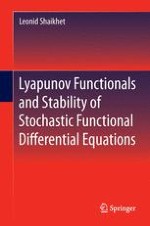2013 | OriginalPaper | Buchkapitel
11. Stability of SIR Epidemic Model Equilibrium Points
verfasst von : Leonid Shaikhet
Erschienen in: Lyapunov Functionals and Stability of Stochastic Functional Differential Equations
Verlag: Springer International Publishing
Aktivieren Sie unsere intelligente Suche, um passende Fachinhalte oder Patente zu finden.
Wählen Sie Textabschnitte aus um mit Künstlicher Intelligenz passenden Patente zu finden. powered by
Markieren Sie Textabschnitte, um KI-gestützt weitere passende Inhalte zu finden. powered by
